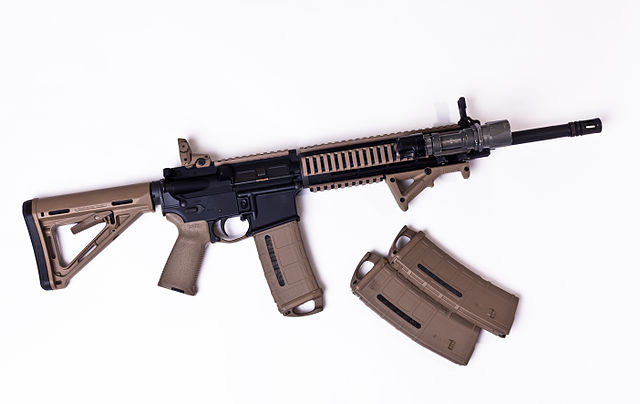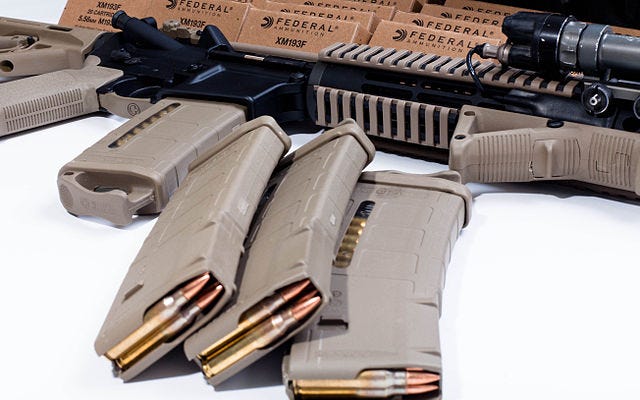In the Wake of Maine: AR-15s ... What the Doctors Say
No, all weapons aren't the same--and the AR-15 is no rifle.
They are, shockingly, commonplace. They occur in night clubs and malls and synagogues and … schools. As of this morning, there have been 203 mass shootings in the United States in the first four months and one week of this year. Among their victims there have been 94 children who have died and 217 who have been injured.
Gun violence across the boards is staggering. There have been almost 15,000 gun deaths in the first months of 2023. Suicide, as usual, leads the numbers—but not by much: there have been almost 6,400 homicides.
The worst of deaths, by far, are the ones inflicted by AR-15 assault weapons and their clones. Physicians have decried AR-15s, the clear weapon of choice of mass shooters, because the damage they do to the human body. Part of the reason is that the bullet travels 3x faster than that of a 9mm round. Its muzzle velocity is 3,200 feet per second, rather than the 1,200 feet per second of the 9mm. After it’s traveled a mile, an AR-15 round is still going 1,660 per second.
Another is that the bullet hits the body not at the 370-500 foot-pounds of pressure of a handgun bullet, but at a staggering 1,350 foot-pounds of pressure. And when it hits the body, it pulverizes muscle, ligament, tendon, vital organs, blood vessels and arteries.
Trauma physicians and surgeons have been trying to talk to us for years. Here is some of what they have tried to tell us:
I was looking at a CT scan of one of the mass-shooting victims from Marjory Stoneman Douglas High School, who had been brought to the trauma center during my call shift. The organ looked like an overripe melon smashed by a sledgehammer, and was bleeding extensively. How could a gunshot wound have caused this much damage? — Dr. Heather Sher, Radiologist, Florida
"The difference with high velocity bullets and military-grade weapons...is the damage they inflict on the human body and our internal organs are much more gruesome and tend to have what is known as a blast effect, because that bullet is carrying so much energy with it as it enters the human body," one doctor said. "Instead of, for example, if the bullet traveled through the lung, instead of a hole in the lung, we're looking at an exploded lung."
"Children, their organs are a lot more compact, and they have a lot less fat surrounding their vital organs," Dr. Cornelia Griggs (Nashville) said. "And so, you can imagine that a bullet that is causing a blast effect inside their body, inside their abdomen or their torso or their chest, it's not just going to explode, or tear apart, their lung, but also their heart. Not just going to completely shatter their liver, but also their spleen, causing catastrophic fatal bleeding."
One of the trauma surgeons opened a young victim in the operating room, and found only shreds of the organ that had been hit by a bullet from an AR-15, a semiautomatic rifle that delivers a devastatingly lethal, high-velocity bullet to the victim. Nothing was left to repair—and utterly, devastatingly, nothing could be done to fix the problem. The injury was fatal.
The bullet from an AR-15 passes through the body like a cigarette boat traveling at maximum speed through a tiny canal. The tissue next to the bullet is elastic—moving away from the bullet like waves of water displaced by the boat—and then returns and settles back. This process is called cavitation; it leaves the displaced tissue damaged or killed. The high-velocity bullet causes a swath of tissue damage that extends several inches from its path. It does not have to actually hit an artery to damage it and cause catastrophic bleeding. Exit wounds can be the size of an orange.
"When we see a child who has been shot with an AR-15-style rifle, there is often very little hope -- depending on where the bullet has hit them in their body -- that we can save their life even if they make it to the hospital," she said. "And devastatingly, the children who were shot in Nashville were dead on arrival to the hospital. There's nothing that the trauma surgery team could do and that is very classic of what we have come to see as the norm."
One doctor treated a patient who took an AR-15 round to the femur.
Where there should have been bone, there was 3” of dust.
There is yet another issue here: the size of the bullet—and the magazine. Below is a small AR-15 magazine. Note the size of the bullet—far larger than one used in a handgun. When an AR-15 is fired, the bullet may start to tumble, so that when it enters the body it is spinning end over end. As with all AR-15 wounds, the exit wound may be many times larger than the entrance wound—whereas the entrance and exit wounds of a 9mm, for example, are virtually the same size.
It isn’t just the size, shape, and velocity of the bullet—it’s how fast an AR-15 can be fired. An average is around 45 rounds per minute. Standard magazines come in 10-, 30-, 60- and 100-bullet clips.
The rapid rate of firing allows a shooter to pump multiple bullets into each victim, ensuring each will die. Nashville’s trauma surgeon, Dr. Cornelia Griggs, describes victims with multiple injuries.
"We'll see people who come in not with one hole or two holes but with six, eight, 10 holes and trying to sort of piece that out to figure out what organ systems might be injured based on the trajectory, just trying to determine what that trajectory is can be significantly more complicated. … In general, I would expect the prognosis for someone who's been shot with a military-grade weapon to be much worse, the likelihood of getting them out of the trauma bay to the operating room to survive the hospital stay, I would be much less optimistic," Griggs said.
Last week in Allen, Texas, a member of the local hospital’s trauma unit waited outside the mall for his daughter (hopefully) to emerge. Police wouldn’t let him inside so he treated the wounded on the asphalt in the parking lot. The devastating explosions that go on inside the bodies of this shot with an AR-15 had caused so much damage that every one of them died on the pavement before his daughter emerged and ran into his arms.
A last word from Dr. Heather Sher:
I have now seen high-velocity AR-15 gunshot wounds firsthand, an experience that most radiologists in our country will never have. I pray that these are the last such wounds I have to see, and that AR-15-style weapons and high-capacity magazines are banned for use by civilians in the United States, once and for all.
We wholeheartedly agree.



